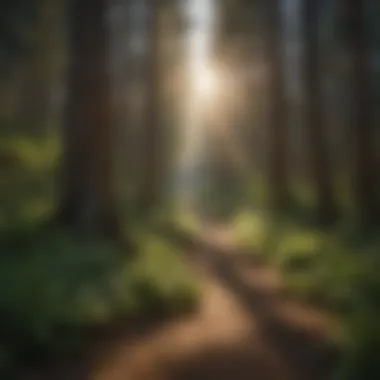Ubox Utah: Urban Forestry and Sustainability Guide


Intro
Urban environments around the world are increasingly recognizing the vital role that green spaces and forests play in maintaining ecological balance. Ubox Utah stands at the forefront of this movement, merging urban forestry with sustainability practices.
In this article, we will delve into several critical aspects concerning Ubox Utah, emphasizing the significance of woodland ecosystems, sustainable forestry practices, and effective stewardship techniques. We aim to equip forestry professionals and academics with detailed insights into how urban forestry initiatives like Ubox Utah contribute to environmental preservation and biodiversity enhancement.
Understanding Woodland Ecosystems
Woodland ecosystems are complex and dynamic systems that balance numerous biological, physical, and chemical processes. Understanding these ecosystems is vital for promoting sustainable urban forestry initiatives.
Importance of Biodiversity in Forests
Biodiversity refers to the variety of life within a particular ecosystem. Forests act as critical habitats for numerous species, contributing to their survival and adaptation. High biodiversity levels allow ecosystems to withstand shocks and stresses, ensuring resilience against diseases and climate change.
Key benefits of biodiversity in forests include:
- Maintenance of ecosystem functions and services
- Natural pest control mechanisms
- Pollination of plants
Role of Forests in Climate Regulation
Forests are instrumental in regulating the Earth's climate. They absorb carbon dioxide from the atmosphere and produce oxygen, making them essential for combating climate change. Urban forests specifically can help reduce urban heat islands, improve air quality, and manage stormwater runoff.
"Urban forestry offers a remarkable potential to mitigate urban climate impacts while enhancing community spaces and biodiversity."
Sustainable Forestry Practices
Implementing sustainable forestry practices is crucial for the health and longevity of forest ecosystems. These methods seek to balance the need for timber and resources with ecological preservation.
Principles of Sustainable Forestry
Sustainable forestry involves managing forest resources in a way that meets current needs without compromising the ability of future generations to meet theirs. Key principles include:
- Managing with a landscape approach
- Protecting water quality and soil health
- Ensuring sustainable timber harvesting
Case Studies of Successful Implementations
Various communities have successfully implemented sustainable forestry principles, serving as models for others. For instance, the Metropolitan Greenspaces program in Minnesota promotes urban forestry initiatives that integrate ecological health with community needs. Their approach enhances biodiversity while addressing urban development pressures.
Woodland Stewardship Techniques
Adopting stewardship practices ensures long-term sustainability of urban forests. These techniques aim to preserve, restore, and enhance wooded areas.
Forest Management Plans
A forest management plan outlines strategies for maintaining healthy forests. These plans consider the unique needs of the ecosystem while also addressing community interests. Implementing clear management plans can significantly improve the ecological integrity of urban woodlands.
Conservation Strategies
Conservation strategies play a pivotal role in maintaining forest ecosystems. This can include protecting critical habitats, restoring degraded areas, and ensuring that forest resources are used wisely. Through targeted conservation efforts, urban forests can thrive and continue serving their ecological and community roles.
With the understanding of woodland ecosystems, sustainable practices, and stewardship techniques, we can more effectively support initiatives like Ubox Utah that dedicate themselves to enhancing urban forestry.
Understanding Ubox Utah
In discussing sustainability and urban forestry, it is essential to grasp the concept and framework of Ubox Utah. This initiative reflects not only a shift towards environmental awareness but also the integration of sustainable practices into urban planning. The importance of this topic cannot be understated. Ubox Utah offers a blueprint for urban landscapes striving to balance development with ecological stewardship.
The Concept of Ubox
Ubox represents a unique approach to urban forestry; it is centered around sustainable practices that promote the health of ecosystems in urban settings. This concept emphasizes growing urban green spaces, which can mitigate pollution, enhance biodiversity, and contribute positively to the urban microclimate. The core idea of Ubox is to transform how communities interact with their environment by encouraging active participation in maintaining these green spaces. This is especially vital in densely populated areas where natural landscapes have been lost to development.
Benefits of the Ubox model include:


- Environmental sustainability: By integrating green practices, Ubox seeks to reduce the ecological footprint of urban areas.
- Community involvement: It fosters a sense of ownership and responsibility among residents.
- Aesthetic value: Well-maintained urban green spaces enhance the visual appeal of cities, promoting a higher quality of life.
Origins of Ubox Utah
The origins of Ubox Utah can be traced back to growing concerns over urban sprawl and its impacts on local ecosystems. As cities expanded, natural habitats were destroyed, leading to a decrease in biodiversity and an increase in green inequity. Ubox was conceived as a response to this crisis, aiming to create a sustainable framework for integrating forestry practices within urban development.
Key milestones in the development of Ubox Utah include:
- The initial proposal emerged from local environmental groups advocating for greener urban areas.
- In collaboration with forestry experts, Ubox Utah was tested in small pilot programs, gathering valuable data on its effectiveness.
- Successful pilots led to citywide implementation, making it a model for similar initiatives in other regions.
Historically, Ubox Utah serves as a case study for cities embarking on the journey towards sustainability. It showcases how dedicated efforts can lead to effective urban forestry practices that address the pressing environmental issues of our time.
Urban Forestry: An Overview
Urban forestry is an essential element in promoting sustainability within urban environments. It involves managing trees and green spaces in cities to improve quality of life while also providing ecological benefits. In the context of Ubox Utah, urban forestry plays a significant role in creating resilient urban ecosystems. Through thoughtful planning and management, Ubox Utah demonstrates how integrating nature into urban areas can have a positive impact on the environment, economy, and community well-being.
Definition and Importance
Urban forestry refers to the practice of planting, maintaining, and managing trees in urban settings. The importance of this practice cannot be overstated. It enhances air quality, reduces urban heat, and contributes to biodiversity. Additionally, urban forestry can mitigate stormwater runoff, which is a common challenge in cities. Integrating trees and green spaces into city planning supports the broader goal of achieving environmental sustainability.
Benefits of Urban Forestry
Environmental
The environmental benefits of urban forestry are numerous. Trees help purify air by absorbing pollutants and producing oxygen. They can also significantly reduce urban heat islands, lowering temperatures and energy costs. Moreover, trees play a crucial role in stormwater management by absorbing rainfall and reducing runoff. This contributes to a healthier ecosystem in cities. One key characteristic is their ability to improve urban biodiversity by providing habitats for various species. This makes urban forestry a beneficial component of Ubox Utah’s sustainability initiatives.
Social
Socially, urban forestry enhances community well-being. Green spaces are associated with improved mental health, and they provide venues for recreation and social interactions. The presence of trees can increase the aesthetic appeal of neighborhoods, fostering a sense of pride among residents. Importantly, urban forestry initiatives can promote community engagement as residents participate in planting and caring for trees. This active involvement strengthens social bonds, making urban forestry a popular choice in community development efforts.
Economic
Economically, the contributions of urban forestry are significant. Trees can increase property values, making neighborhoods more desirable. Furthermore, urban forests can reduce costs associated with energy use as trees provide shade and cool surrounding areas. They can also attract tourism and enhance local business opportunities. The unique feature of trees in urban areas is their ability to create attractive settings that draw visitors and stimulate economic growth. Thus, urban forestry offers considerable advantages for economic sustainability.
"Integrating trees into urban planning is not just about aesthetics; it’s about enhancing life quality and fostering sustainable communities."
Overall, urban forestry forms a vital part of sustainability frameworks such as Ubox Utah. By understanding its definition, importance, and multifaceted benefits, one can appreciate how urban forestry not only enhances the urban landscape but also contributes to ecological stewardship.
Sustainable Practices in Ubox Utah
Sustainable practices in Ubox Utah play a crucial role in ensuring the long-term viability of urban forestry. As cities grow and urban spaces expand, the need for effective management of green resources becomes imperative. Sustainable practices not only mitigate environmental impact but also enhance community resilience. Urban forestry, when implemented sustainably, can improve air quality, support biodiversity, and provide recreational spaces for the community.
One significant aspect of sustainable practices is the emphasis on balancing ecological health with the economic needs of urban development. This includes integrating green spaces into city planning, promoting biodiversity, and fostering a healthy ecosystem. Practical implementation requires collaboration among diverse stakeholders, including local governments, businesses, and residents.
Sustainable Forestry Methods
Sustainable forestry methods are vital for maintaining healthy forest ecosystems while meeting the various demands of urban communities. These methods vary in application but share a common goal of ensuring the long-term sustainability of forest resources. Evidence shows that when implemented effectively, these methods can lead to improved forest health and increased community satisfaction.
Innovative Techniques for Woodland Management
Innovative techniques in woodland management are essential for adapting to changing environmental conditions and urban pressures. These techniques often incorporate modern advancements in technology alongside traditional practices.
Agroforestry
Agroforestry represents an approach that combines agriculture and forestry practices to create more integrated, diverse, and productive landscapes. This technique contributes significantly to sustainability by enhancing biodiversity and improving soil health. A key characteristic of agroforestry is its ability to generate multiple outputs from the same area, leading to a more efficient use of resources.
The unique feature of agroforestry is its focus on perennial crops, which can yield benefits such as improved water retention and reduced soil erosion. Although it presents challenges like initial infrastructure costs and the need for specialized knowledge, the long-term benefits often outweigh these disadvantages.
Selective Logging
Selective logging is a forestry practice focused on harvesting a limited number of trees while retaining the overall structure of the forest. This approach minimizes ecological disruption and maintains habitat for various species. A key characteristic of selective logging is its potential to promote forest regeneration. This makes it a beneficial choice for regions attempting to balance economic needs with environmental protection.
The notable aspect of selective logging is its focus on species selection, ensuring that only mature or non-essential trees are removed. While it encourages sustainability, challenges might arise regarding monitoring the impacts and controlling illegal logging practices.


Reforestation
Reforestation involves planting trees in areas that have been deforested or degraded. This practice is critical to restoring ecosystems and sequestering carbon. A key characteristic of reforestation is its focus on using native species, which are more adaptable and supportive of local wildlife.
The unique feature of reforestation is its ability to provide immediate ecological benefits, including improved wildlife habitat and enhanced soil fertility. However, there are disadvantages, such as the risk of monoculture if species selection is not managed carefully. Thus, proper planning and follow-up support can enhance its effectiveness in urban forestry initiatives.
Community Engagement and Education
Community engagement and education are essential components in the success of urban forestry initiatives like Ubox Utah. These elements not only enhance community awareness but also foster a sense of stewardship among residents. Engaging the community allows individuals to contribute to environmental efforts, creating a more profound impact on local ecosystems.
Strong community involvement leads to democratic participation in decision-making processes that affect urban landscapes. Residents who understand the importance of urban forestry can advocate for sustainable practices within their neighborhoods. This collective action results in greater success in achieving ambitious sustainability goals.
Educational initiatives also play a critical role in this landscape. Through awareness programs, workshops, and training, residents can learn effective strategies to promote biodiversity and conservation in their areas. It helps break down complex sustainability issues into manageable steps that every community member can partake in.
As more people understand the benefits of urban forestry, the overall support for initiatives like Ubox Utah increases. Community trust and responsibility grow, leading to enhanced collaboration among stakeholders, including government bodies and environmental organizations.
Role of Community in Urban Forestry
The role of the community in urban forestry cannot be overstated. When residents take an active part in their local ecological practices, it brings many benefits.
- Awareness and Knowledge Sharing: Community members can share their knowledge and experiences with each other. This exchange builds a collective consciousness regarding urban forestry efforts.
- Local Advocacy: Engaged residents are more likely to advocate for sustainable policies and practices. This aids in influencing local governance on environmental issues.
- Project Participation: Volunteer opportunities allow residents to participate in tree planting, maintenance, and restoration projects. This hands-on involvement helps develop a sense of ownership and pride in their environment.
Furthermore, communities can create local partnerships with schools and organizations to bolster their impact. Community gardens, nature trails, and green spaces become focal points, improving overall urban quality while enhancing relationships among residents and fostering environmental responsibility.
Educational Initiatives and Workshops
Educational initiatives and workshops are fundamental in building a knowledgeable community around urban forestry practices. These programs serve as platforms for skills sharing and active learning.
- Workshops: Hands-on workshops can include topics such as tree identification, proper planting techniques, and maintenance of green spaces. Practical knowledge empowers residents to take action at the local level.
- School Programs: Integrating forestry education into school curricula ensures that children learn the importance of protecting their environment from a young age. Schools can organize field trips to local parks to enhance this learning further.
- Collaboration with Experts: Partnering with forestry professionals and ecologists can provide community members with insights and research-based practices, ensuring that educational content is credible and applicable.
These initiatives encourage community members to take active roles in their environment. They develop skills that lead to better maintenance of urban ecosystems and contribute positively to the local economy. By prioritizing education in urban forestry, Ubox Utah strengthens its community ties and enhances ecological stewardship.
Education and community involvement are not just about action; they foster a culture of awareness that transcends individual efforts.
Ecological Benefits of Ubox Utah
Ubox Utah is more than just a theoretical framework for urban forestry; it has tangible ecological benefits that enhance both local environments and broader ecosystems. Understanding these benefits helps underscore why Ubox is an essential part of sustainability discussions in urban contexts. Through careful management and unique methodologies, Ubox Utah sparks a biologically diverse and resource-rich environment.
Enhancing Biodiversity
One of the primary ecological benefits of Ubox Utah is the enhancement of biodiversity within urban landscapes. Biodiversity refers to the variety of life forms in a certain area, encompassing different plants, animals, fungi, and microorganisms. By promoting the planting of native species and establishing various habitats, Ubox Utah allows for a richer ecosystem.
The potential advantages of increased biodiversity include:
- Improved ecosystem resilience against diseases and pests.
- Greater stability in food webs.
- Enhanced pollination services crucial for flowering plants.
Ubox's focus on local flora and fauna supports wildlife habitats, providing essential refuge for native species. This leads to better pollinator populations and healthier soil, directly impacting agricultural outputs in nearby areas.
Erosion Control and Water Management
Erosion control and proper water management are critical ecological benefits of Ubox Utah. Urbanization typically leads to soil erosion and water runoff issues, threatening both infrastructure and ecosystems. By integrating green spaces, Ubox Utah employs trees and vegetation strategically, which helps stabilize soil and reduce erosion.
Some ways Ubox Utah addresses these challenges include:
- Tree Canopy Coverage: Trees absorb rainwater, significantly reducing runoff.
- Root Systems: The extensive root systems of trees hold soil in place, mitigating erosion risks.
- Water Infiltration: Vegetation promotes water infiltration, enhancing groundwater recharge.
Overall, these strategies lead to healthier water cycles and better quality water in urban areas, benefiting both humans and wildlife.
"Strategic urban forestry initiatives like Ubox Utah are vital not only for environmental health but also for community well-being."
Through fostering biodiversity and enhancing water management, Ubox Utah stands as a promising model for urban ecology. These ecological benefits highlight its role in shaping sustainable cities, making it a compelling case for broader adoption in urban forestry initiatives.
Challenges in Implementing Ubox Utah


Urban forestry is complex. Ubox Utah faces many challenges that hinder its optimization. Understanding these barriers is essential for professionals involved in sustainable practices. Addressing these challenges effectively can enhance community resilience and promote ecological benefits.
Barriers to Urban Forestry Initiatives
The challenges in initiating urban forestry projects often stem from multiple factors. First, awareness issues can limit participation in programs like Ubox Utah. Many citizens do not understand the importance of urban forestry. This lack of knowledge can prevent community engagement.
Second, regulatory hurdles are significant. Sometimes, local regulations restrict where and how trees can be planted. Excessive bureaucracy can slow down the approval process. This makes it harder to implement sustainable projects rapidly.
Additionally, competition for land can be a significant concern. Urban areas are often developed for housing and commercial purposes, leaving little space for green initiatives. This scarcity of land for forestry complicates planning efforts.
Funding and Resource Allocation
Financial constraints are a major factor in the success of Ubox Utah. Securing adequate funding is crucial for urban forestry projects. Many local governments struggle with budget limitations, which affects their ability to allocate resources effectively.
"Funding is often at the heart of limitations in implementing urban forestry initiatives. Without financial backing, programs cannot thrive."
Moreover, resource allocation also plays a role. Personnel trained in sustainable practices are essential for the success of Ubox Utah. However, finding and retaining such skilled workers is challenging. This issue affects the implementation of effective management strategies.
In summary, addressing these challenges requires a concerted effort. Engaging community members, navigating regulatory environments, and securing funding will be crucial steps. Success in these areas can bolster the objectives of Ubox Utah, creating a more sustainable urban environment.
Case Studies: Successful Applications of Ubox Utah
Case studies are vital for understanding the practical implications of Ubox Utah's principles of urban forestry and sustainability. By examining localized efforts and achievements, we grasp the benefits and challenges that come with these implementations. This section will focus on two main topics: local success stories and lessons learned from other regions. Each subsection aims to provide insights that can inspire further development and adoption of similar sustainable practices.
Local Success Stories
Local success stories illustrate the tangible effects of Ubox Utah's approach to urban forestry. One notable example is the community-led initiative in the downtown area of Salt Lake City, where residents collaborated with city officials to plant over 500 trees. This project not only beautified the environment but also enhanced air quality and reduced urban heat. The initiative demonstrated how local engagement drives successful outcomes.
Such projects yield a variety of benefits:
- Improved Air Quality: Increased greenery contributes to cleaner air by absorbing pollutants.
- Community Cohesion: Collaborative efforts foster a sense of belonging and investment in city spaces.
- Aesthetic Value: Enhanced landscapes can boost local property values and attract tourism.
Another success can be seen in the Ogden River Parkway project, where invasive species were removed to make room for native tree species. This restoration promoted biodiversity and provided habitats for local wildlife, showcasing how Ubox Utah's methods can revitalize local ecosystems. The project not only affected ecological health but also became a recreational area for the public, enhancing community well-being.
Lessons from Other Regions
Learning from other regions can significantly inform the development of Ubox Utah initiatives. One enlightening instance is the Portland Urban Forestry Program, which focuses on data-driven approaches to urban tree management. Their methods include regular monitoring and assessments to determine tree health and site suitability. This model emphasizes the importance of continual evaluation for the success of urban forestry programs.
Key takeaways from this program include:
- Data Utilization: Regular assessments lead to informed decision-making about tree management.
- Resource Allocation: Prioritize areas with the most pressing needs for tree planting and care.
- Community Outreach: Engage the public to inform them about urban forestry benefits and how they can contribute.
In addition, the successful reforestation efforts in cities like Atlanta highlight the impact of strategic planning. By focusing on ecological equity, the program seeks to ensure that all neighborhoods, especially under-resourced areas, benefit from urban forestry practices. Such an inclusive approach can be very inspirational for Ubox Utah, emphasizing benefits beyond just the environment, fostering social equity and community health as well.
Efficient case studies not only document success but also pave the way for scalable solutions and methodologies in urban forestry.
Future Directions of Ubox Utah
Urban forestry is crucial for the sustainability of cities, and Ubox Utah represents a significant step forward in this field. The implications of future directions within Ubox Utah encompass various aspects, including environmental, social, and educational factors.
The commitment towards sustainability has never been more vital. As urban areas expand, the need for innovative approaches to forest management and community involvement becomes critical. Ubox Utah aims to integrate cutting-edge trends and advancements that will shape not only the urban landscape but also the quality of life for its residents.
Emerging Trends in Urban Forestry
Urban forestry is evolving with several trends that are transforming how we view and manage urban green spaces. A key trend is the incorporation of technology into forestry practices. Geographic Information Systems (GIS) and remote sensing are becoming standard tools for mapping, analyzing, and managing urban forests. This allows for more precise interventions and the ability to monitor changes over time.
Another significant trend is the movement towards community-led initiatives. Engagement at the community level fosters a sense of ownership and responsibility towards urban forestry. Programs that involve local residents in tree planting and care directly impact the health of the ecosystem and the social fabric of communities.
Additionally, the recognition of green infrastructure is gaining momentum. This refers to utilizing natural systems to manage stormwater, reduce heat islands, and improve air quality. Green roofs, permeable pavements, and urban woodlands are all part of this trend, which promotes resilience against climate change.
Advancements in Sustainability Practices
Sustainability practices are essential for the longevity and health of urban forests. Ubox Utah will embrace several key advancements in this area. Firstly, the focus on native species planting cannot be understated. Native plants support local biodiversity and are better suited to the climate and soil conditions, making them more resilient to pests and diseases.
Secondly, adaptive management techniques are increasingly important. This approach allows for ongoing assessment and modification of management strategies based on ecological responses and changing environmental conditions. It promotes flexibility and responsiveness in forestry practices.
Furthermore, education and outreach programs are advancing to better inform the community about the benefits of urban forestry. Engaging the public about the importance of trees and green spaces fosters a culture of stewardship and sustainability. Workshops, online resources, and local events can equip residents with knowledge and tools to contribute effectively to urban forestry efforts.
Urban forestry not only beautifies cities but also plays a crucial role in tackling urban challenges.







